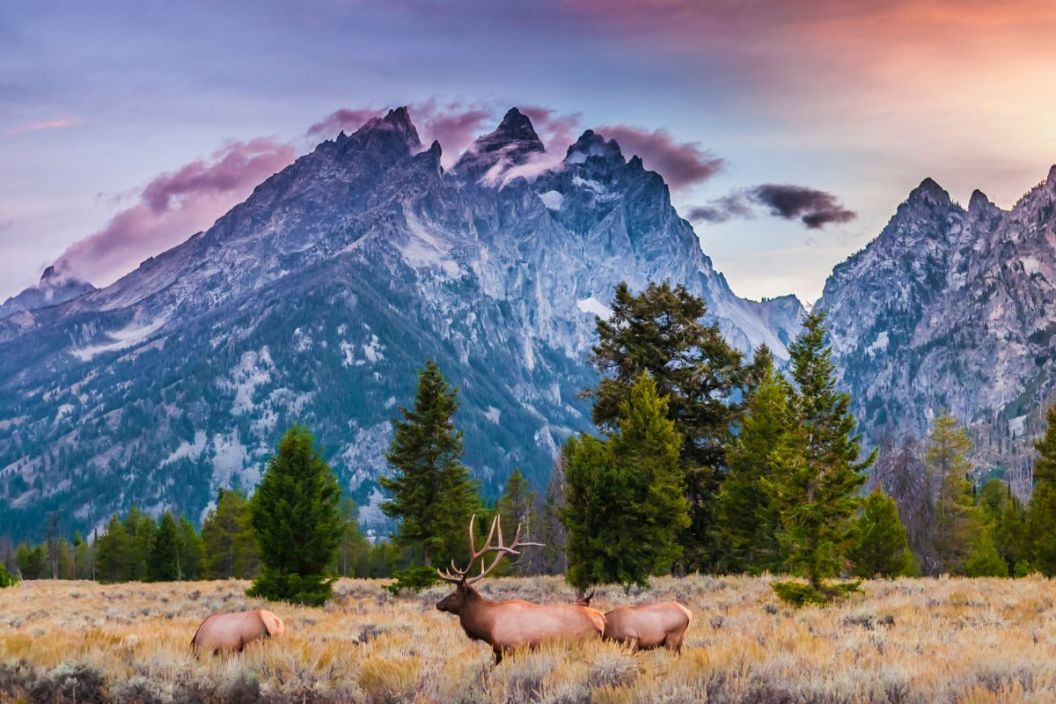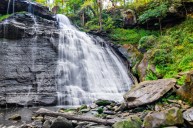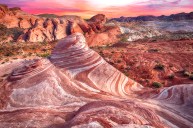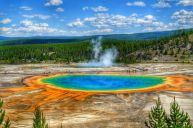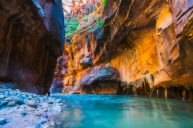From lush forests in the Pacific Northwest, to scenic drives in the Southeast, to celestial mountains and striking red rocks in the Southwest, America has never been at a loss to present natural beauty to those looking. And when you consider the 423 designated national park sites, it can be hard to narrow down which is the best national park in the USA and, therefore, worth your vacation days.
We're here to help. First, consider what you want to do most in the park: For every outdoor activity, from fishing to backpacking to stargazing, the protected, nearly-untouched wilderness of national parks has it in plenty. If you're traveling with rowdy kids or with your four-legged friends, we've also got a top park for you.
While we don't cover every outdoor sport or park draw here, we also have guides on the best national parks for kayaking, the best to visit in the winter, and the best to visit when you want the park all to yourself.
But for those looking for the highlight reel of the best national parks USA has to offer, check out these nine national parks, ideal for every kind of outdoorsy person.
Best National Park for Fishing: Everglades National Park

SimonSkafar via Getty Images
While plenty of well-known national parks in the USA offer great fishing, this Florida paradise offers species that are almost entirely different from the others. Everglades National Park is the largest subtropical wilderness in the country and serves as a refuge for endangered species such as manatees, Florida panthers, and crocodiles. But the park is also a fishing wonderland.
Offering both saltwater and freshwater fishing, the beautiful wetland has a variety of incredible fishing areas that hold redfish, speckled trout, tarpon, snook, cobia, permit, peacock bass, and largemouth bass.
Note that the National Park Service does warns of high mercury levels found in Everglades bass and other species in northern Florida Bay. Any bass caught north of Main Park Road shouldn't be consumed, while bass caught south of the road shouldn't be eaten more than once a week. Saltwater species also caught in the northern Florida Bay shouldn't be eaten more than once a week including spotted seatrout, gafftopsail, catfish, bluefish, crevalle jack, or ladyfish.
Fishing licenses are required except for Florida residents that fish from the shore. Anglers that are 16 years old and up will need separate freshwater and saltwater Florida fishing licenses, and three-day licenses costs $17. Make sure you pick up a current copy of the Everglades Fishing Regulations available at all visitor centers and entrance stations before you head out on the waters.
Best National Park for Camping & Backpacking: Glacier National Park
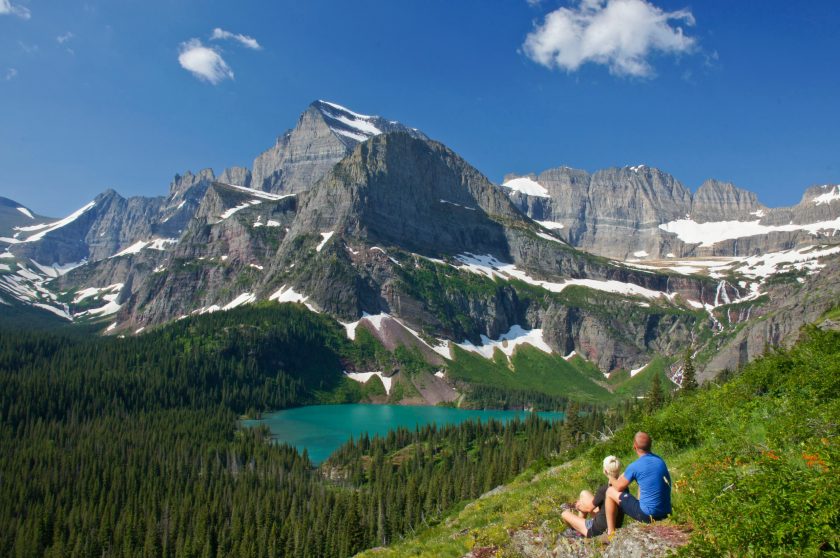
Bkamprath via Getty Images
While backpacking in a national park might make you think of Yellowstone or Yosemite National Park, both were topped for our list by Glacier National Park, thanks to its insane amount of rugged wilderness to explore.
This Montana park has 700+ miles of backcountry trails that run through pristine alpine lakes, glacier-covered mountain peaks, wildflower-filled meadows, and deep valleys, along with 1,000+ campsites to choose from. Every camping area comes with a view worthy of a screen saver. And if you don't have the time to commit to backpacking, there is no shortage of amazing shorter trails for to view some of the best hikes.
Along its gorgeous landscape, backpackers will also probably run into some of the park's extraordinary wildlife including bighorn sheep, mountain goats, black and grizzly bears, bobcats, gray wolves, cougars, coyotes, elk, moose, bison, and Canadian lynxes.
The best time to visit the park may vary year to year, but is normally in between late July and late September. You'll need backcountry camping permits to access the park's 65 backcountry campgrounds, and they cost $7 per person, per night. You'll want to make advance reservations since campsites are pretty competitive until after Labor Day, when backcountry use declines. Reservations can only be made online, but if you can't secure one, 30% of the campsites are set aside for walk-in permits. Make sure to arrive as early as you can to snag your campsite because permits aren't issued after 4:30 p.m. at any location.
Best to See Wildlife: Yellowstone National Park
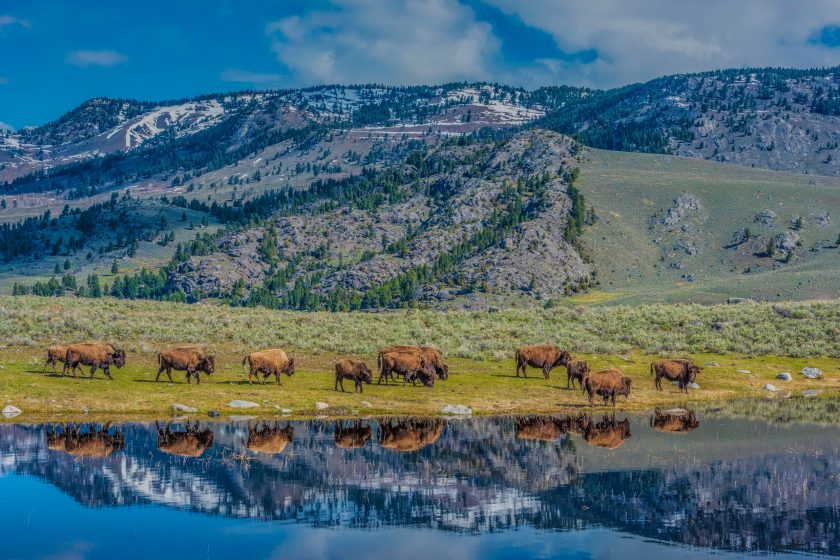
Gerald Corsi via Getty Images
Despite the overcrowding, Yellowstone National Park features some of the richest wildlife viewing in the U.S. It's not only the first national park, but also one of the largest and most-visited national parks because of its famous geysers (hi Old Faithful!), mountainous landscapes, and because it has the largest bison population in the nation.
But bison isn't the only reason why seeing wildlife in this popular national park is worth the crowding chaos: Known as the American Serengeti, the 2.2-million acre park contains the largest concentration of mammal species in the lower 48. This includes elk, grizzly and black bears, mule deer, bighorn sheep, coyotes, wolverines, mountain lions, gray wolves, and pronghorn. You'll find a ton of wolves in Lamar Valley and bison, elk, and grizzlies in Hayden Valley.
Just make sure you know and follow all rules when it comes to viewing wildlife. You don't want to become one of the many idiot tourists that gets injured or worse because you tried to take a selfie with a bear, bison, or some elk.
Best for Stargazing: Great Basin National Park
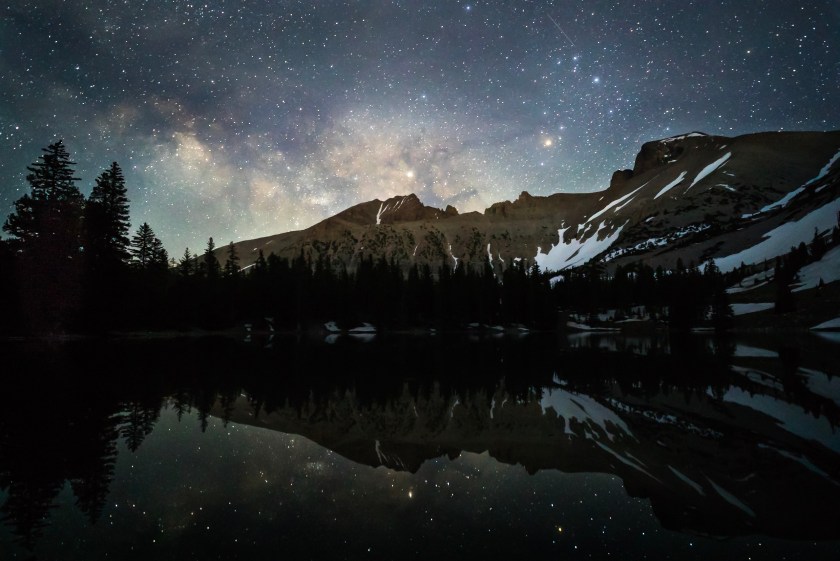
Elizabeth M. Ruggiero via Getty Images
It's easy to forget all that nature has to offer after the sun goes down and most of the tourists go home. International Dark Sky Parks are designated lands that are distinctly known for their nocturnal environments with regulations on lights used at night—which means they're some of the best places to see the stars in the whole world.
And in Nevada, Great Basin National Park is one of these cosmic paradises.
Despite being one of the best national parks in the USA, the park is free to visit all year-round. It also offers some of the darkest night skies left in the U.S. as it's one of the nation's least-populated regions, and its topography is what helps shield the area from skyglow radiating from distant cities.
Bring a pair of 7x50 binoculars, red flashlight, and star chart to some of the park's excellent viewpoints such as Mather Overlook, the Baker Archaeological Site, and the Ranch Interpretive Site for the most stellar sights. Anywhere in the park with an open horizon is a great place to just look up and behold the views.
The park also has fun astronomy programs that typically happen every Saturday from May to September. These include stargazing train rides, guided full-moon hikes, and even an annual astronomy festival.
Best Pet-Friendly National Park: New River Gorge National Park

Kyle Kempf via Getty Images
One of America's newest national parks, New River Gorge in West Virginia and has quickly become the best pet-friendly destinations. Bring your dog (or cat) along to check out the 70,000 acres of gorge created by the New River. The hikes here lead to incredible overlooks, spectacular rock formations, lush woodlands, and breathtaking waterfalls.
You can even bring your pet to the rock-climbing crags as long as you have a fellow climber help watch them while you scale one of the 1,400 established rock climbs. Just make sure that your pet is on a leash that is no longer than six feet at all times and you always pick up their waste.
Best to Bring the Kids: Sequoia and Kings Canyon National Parks

LL28 via Getty Images
Tearing the kids away from a screen and out into nature can be a feat in and of itself. Choosing the right park with easy hikes for little ones, engaging activities, and ideally, natural wonders they can climb all over will make your parenting life immensely easier.
The majestic forests of giant trees in Sequoia and Kings Canyon National Parks in California will certainly not disappoint. Technically two separate national parks, Kings Canyon and Sequoia National Park are less than 20 minutes apart and one day pass covers entry to both.
The parks house some of the world's biggest and oldest trees that can be seen by most of the easy designated hiking trails. Two of the most iconic giant sequoia trees are the General Sherman Tree and the Grant Tree. The General Sherman Tree is the world's largest tree by volume and can be seen in Sequoia National Park. The Grant Tree is historically known as the Nation's First Christmas Tree and is found in Kings Canyon's Grant Grove.
But you don't have to rely on giant trees to keep your kids' attention the entirety of your trip. As two of the best national parks in the USA, the wilderness landscapes offer granite domes to climb, scenic drives, and day hikes to great vistas, serene rivers, and sensational waterfalls. Your kids can learn more about the history of the area through the interactive exhibits at the Giant Forest Museum and participate in the Junior Ranger program.
Traveling to these parks is convenient, too. Free shuttle buses run from campgrounds and the Giant Forest Museum, where there are larger parking areas. Just make sure to bring a small bag for snacks, water, extra clothing, money, and a park map, and your family will be all set for a great time.
Best National Park to See Waterfalls: Mount Rainier National Park
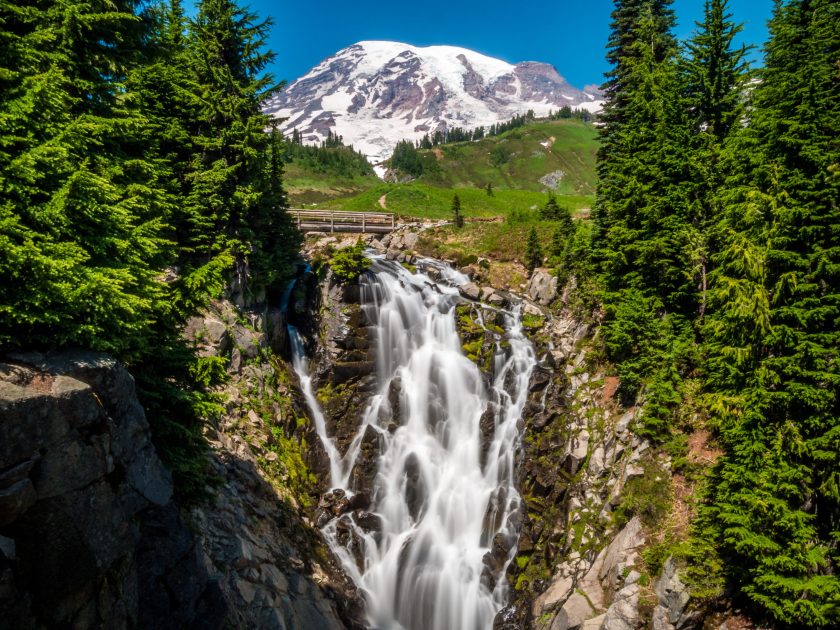
aoldman via Getty Images
Two of the best national parks in the USA to see waterfalls are in Washington state: Olympic National Park and Mount Rainier National Park. You can't go wrong with visiting either, but Mount Rainier tends to be more accessible and, somehow, less busy.
As one of the most glaciated national parks in the lower 48, Mount Rainier has 25 active glaciers that fuel the powerful multitudes of waterfalls and cascades. The region features a diverse range of 150+ waterfalls including different types of cascades, horsetails, and plunges, many towering over 300 feet tall.
The region is an easy day-trip from Seattle, so you can spend an afternoon on one of the 260+ well-maintained trails to see old-growth forests, river valleys, high subalpine meadows, lakes, streams, wildflowers, and of course glaciers. A few of the waterfalls can even be seen on some of the biking trails.
Best for Hunting: Grand Teton National Park
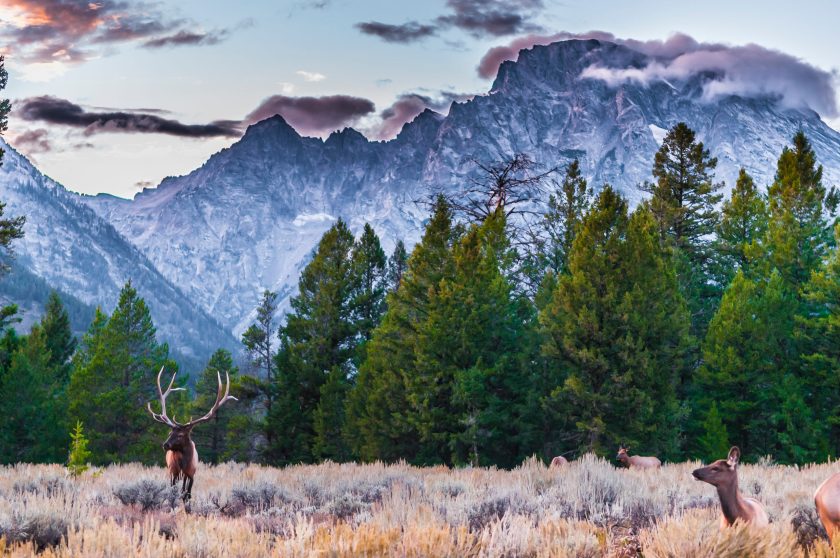
kwiktor via Getty Images
There are a lot of reasons to visit the majestic range that makes up Grand Teton National Park, but one outdoor sport it has that you won't get very many other places: permits to hunt.
Only about one-tenth of U.S. national parks allow hunting, almost all of which actually prohibit sport hunting within park grounds and instead only permitting it within the nearby national preserves.
Wyoming's Grand Teton National Park is not only one of the best national parks in the USA thanks to its wild landscape, but it's also one of the few national parks that allows hunting within park grounds. The park only allows elk hunting and holds an annual elk reduction program some time between mid-October and mid-December based on what elk management looks like that year. Grand Teton elk are part of the Jackson Herd, which is one of the largest elk herds in North America.
Hunters are required to have a Wyoming hunting license and a park permit to participate and should heed the rules and regulations to know which reduction areas are open.
Best to See Fall Foliage: Shenandoah National Park
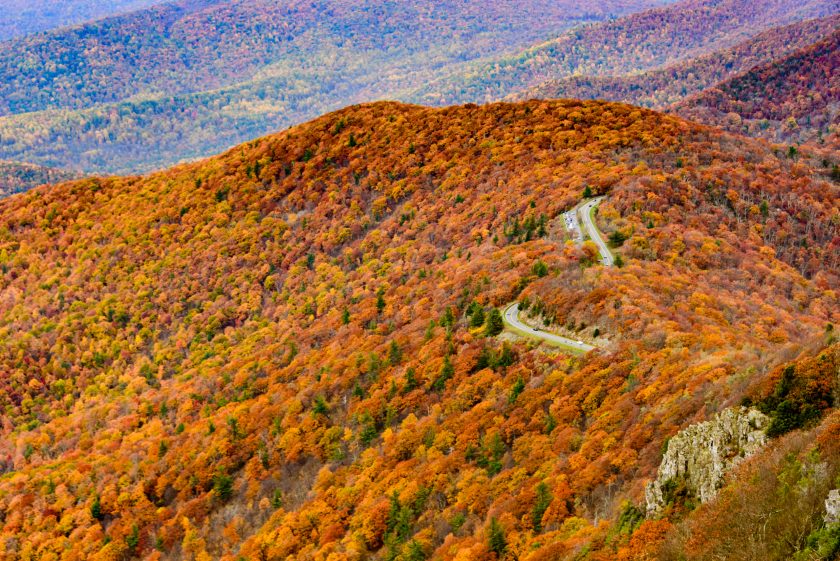
OGphoto via Getty Images
Leaf peeping in the fall is absolutely breathtaking in any open space, but watching the colors turn in Shenandoah National Park is arguably the best out there. Most national parks known for their fall leaves are among the most visited national parks, like Acadia National Park in Maine or Rocky Mountain National Park in Colorado.
Instead, Shenandoah offers serene moments among the reds, oranges, and golden yellows without the crowds on its nearly 80,000 acres of designated wilderness—especially when you consider its just 75 miles from Washington, D.C.
The best time to check out Shenandoah's peak fall foliage is in October. The colors start changing early in the month at higher elevations and make their way down the hillsides and valleys as time passes by. Located in the Appalachian Mountains, the region offers different ways to see its changing leaves. Skyline Drive is the popular 105-mile public road that runs through the park and has 75 different overlooks and pullouts along the way for tourists to stop and behold the views. It runs along the Blue Ridge Mountains crest, but can see heavy traffic on the weekends.
However, you can choose to hike one of the 500 miles of hiking trails to dive into the array of waterfalls and rock formations underneath the vibrant canopy.
READ MORE: Less Busy and More Beautiful Alternatives to Yellowstone National Park
